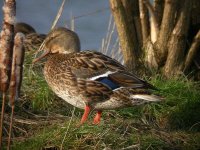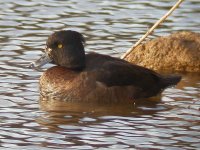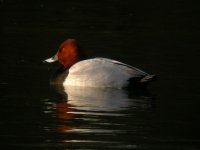
The camera settings used for digiscoping are one of the most frequent requests that I receive, so I thought it would be an idea to state my own and to invite others to share their own settings with the forum.
It would be understandable to assume that every digiscoper would use the same settings.... this isn't the case and there seems to be several ways to reach the same goal. The following settings are for the major digiscoping cameras, the Nikon cp990, cp995 and the cp4500.... some of these may be applicable to other Nikon coolpix cameras and maybe cameras from other manufacturers.
First off, it's important to use your camera in a manual or semi-automatic mode.... programme and auto modes can often give you inappropriate exposure settings for bird photography, maybe giving you a slower shutter-speed in preference to a higher aperture value... the latter is totally irrelevant for digiscoping, extra depth of field is unlikely and far less important than freezing any movement.
Full Manual:
You choose shutter-speed and aperture value....you can judge if the photo will be over/under exposed by the linear exposure meter.
Aperture Priority:
You set the aperture value (lowest available setting is vital) and the camera works out what shutter-speed is appropriate for the given light
Shutter-Priority:
Where you set the shutter-speed and the camera sets the appropriate aperture value for the given light.
I use full manual and tend to under-expose slightly by choosing a slightly faster shutter-speed than the camera recommends to freeze bird/camera movement as much as possible... Correct exposure is often subjective but blur isn't, anyway under-exposure can be rescued in Photoshop, though over-exposure is very difficult to rectify.
Aperture priority is a fairly reliable mode and may be the best bet when the bird is active and you need to get a shot off quickly.
Focus modes:
There is always some debate about what mode produces the sharpest images. I have tried them all over the last 3 1/2 years and still come to the conclusion the 'Macro' (flower symbol) produce the best images. 'Infinity' is handy if you have obstructions (branches/reeds and similar) between the camera and subject as you simply focus on the subject until sharp and the camera will take the shot without trying to find a focus lock itself.
If you do utilise the latter, try to do it with the camera in 'manual focus' with the distance set to infinity rather than using the main 'Infinity' (mountain symbol) focus setting, this seems to give slightly improved results.
In the actual camera menus:
White Balance:
Leave it on Auto, ... you can have a play around with the White Balance preset if you have a white object in view for the camera to take a reading, though not really worth the bother as you can rectify most problems in Photoshop.
Metering:
Now this is quite important as it determines where the camera takes its light reading of the image from, so as to correctly expose the image... Best to ignore matrix metering as it can often lead to the wrong exposure for a small bird against a light/dark background, though if the bird dominates the view it o.k. Spot Metering is useful as the camera will only take a light reading from the centre spot (hopefully where the subject is)... exposing the subject correctly but to hell with the background.
An in-between metering mode is 'Centre Weighted' or 'Partial Spot'..... The camera will concentrate on exposing for the centre spot but doesn't totally ignore the lighting of the background.
Finally, and in combination with a focus mode we will get to later, we have 'Spot AF Area' metering. basically spot metering but at different points around the image. I tend to use this for most of my shots, that's why my backgrounds look too dark or bright!
Continuous:
Fairly straight forward in that you can choose to shoot one shot at a time or a series of shots (about 6 for full size images on the cp4500). Handy to take a burst of shots in quick succession in that you're more likely to capture a good pose with an active bird (diving Ducks)... just delete the crap ones afterwards. There is a price to be paid for using 'Continuous mode' as you will have a fairly long wait while these images are written to the memory card (feels like an eternity if the bird is suddenly posing beautifully).
You can take a single shot whilst in 'Continuous mode', but the write-to-card time is slightly longer than if the image had been taken in 'Single mode'.
There are other multi-shot shooting options, but these can only be used when using lower quality image settings.
BSS:
Nikon's amazing feature for getting sharp images with shaky hands, unfortunately not much use for birds that are moving. The camera keeps taking photos as long as you have the shutter button pressed down, you take your finger off and it will only save what it regards as the sharpest image. A moving subject will totally throw it off, but it can be used for static birds.
Image Adjustment:
This controls the contrast in the final image. Best left on normal, though I prefer low contrast on the cp4500 to help keep blown-out highlights to a minimum. You can always boost contrast in-computer with far more control.
Saturation:
Best left on normal setting. Auto settings on any of the image adjustment controls can leave you at the mercy of the camera's 'brain'.
Sharpening:
See above.
Image Quality:
Always on 'Fine'. This saves the image at a low jpeg compression ratio.... you can't really see any jpeg artefacts in the results. 'Hi' will save the image as an uncompressed Tiff, so this is the ultimate for quality but you'll be waiting 20+ secs before the image is written to the memory card and you can take another shot.
Image Size:
Keep on 2272x1704, which is the maximum size. May be tempting for 35mm people to use 2272x1520 for 3:2 format images rather than 4:3... but a waste of time and pixels as you can crop to 3:2 in-computer.
Focus Options: (3 Sub-menus)
AF Area Mode:
This refers to the Nikon AF zone system that presents five focus targets that you can choose from, in auto the camera will focus on the zone that has an object closest to the camera... in manual you can choose which zone the camera will focus on (via the mini joystick). This handy for 'nice' compositions with the bird off-centre.
You may have guessed by now that the 'Spot AF Area' metering mode that I mentioned earlier is linked to these focus targets... you will get spot metering over the active target (active target is highlighted red on the screen).
I'd recommend using 'AF Area Mode' in manual combined with the 'Spot AF Area' metering mode... if nothing else it will help the camera focus on what you want it to rather than some twig in the bottom of the image (even that's not foolproof).
Auto-Focus Mode:
Absolutely vital to switch it to 'Single AF', seems to be the default setting these days.... but check it if your camera is constantly searching for something to lock onto when you're in a manual/semi-auto mode.
Focus Confirmation:
Tricky one.... highlights the area in-focus on your screen, so you can focus your scope and know when the subject is in-focus because it 'twinkles' (for want of a better word). It can make your eyes go a bit funny on the older Nikons, better on the newer ones. Not totally reliable and I find my own judgement of what is in perfect focus to be more reliable on many occasions, so have it switched off. If I go through a rough patch of 'iffy' photos I'll switch it on again in desperation.... but usually switch it off again when I realise something else was to blame for the 'iffy' pics.
Focus Confirmation can make the view look very 'bitty' when used with an Extend-a-view sunshade2x loupe.
That's about it for my settings.... what about yours?
Andy B
It would be understandable to assume that every digiscoper would use the same settings.... this isn't the case and there seems to be several ways to reach the same goal. The following settings are for the major digiscoping cameras, the Nikon cp990, cp995 and the cp4500.... some of these may be applicable to other Nikon coolpix cameras and maybe cameras from other manufacturers.
First off, it's important to use your camera in a manual or semi-automatic mode.... programme and auto modes can often give you inappropriate exposure settings for bird photography, maybe giving you a slower shutter-speed in preference to a higher aperture value... the latter is totally irrelevant for digiscoping, extra depth of field is unlikely and far less important than freezing any movement.
Full Manual:
You choose shutter-speed and aperture value....you can judge if the photo will be over/under exposed by the linear exposure meter.
Aperture Priority:
You set the aperture value (lowest available setting is vital) and the camera works out what shutter-speed is appropriate for the given light
Shutter-Priority:
Where you set the shutter-speed and the camera sets the appropriate aperture value for the given light.
I use full manual and tend to under-expose slightly by choosing a slightly faster shutter-speed than the camera recommends to freeze bird/camera movement as much as possible... Correct exposure is often subjective but blur isn't, anyway under-exposure can be rescued in Photoshop, though over-exposure is very difficult to rectify.
Aperture priority is a fairly reliable mode and may be the best bet when the bird is active and you need to get a shot off quickly.
Focus modes:
There is always some debate about what mode produces the sharpest images. I have tried them all over the last 3 1/2 years and still come to the conclusion the 'Macro' (flower symbol) produce the best images. 'Infinity' is handy if you have obstructions (branches/reeds and similar) between the camera and subject as you simply focus on the subject until sharp and the camera will take the shot without trying to find a focus lock itself.
If you do utilise the latter, try to do it with the camera in 'manual focus' with the distance set to infinity rather than using the main 'Infinity' (mountain symbol) focus setting, this seems to give slightly improved results.
In the actual camera menus:
White Balance:
Leave it on Auto, ... you can have a play around with the White Balance preset if you have a white object in view for the camera to take a reading, though not really worth the bother as you can rectify most problems in Photoshop.
Metering:
Now this is quite important as it determines where the camera takes its light reading of the image from, so as to correctly expose the image... Best to ignore matrix metering as it can often lead to the wrong exposure for a small bird against a light/dark background, though if the bird dominates the view it o.k. Spot Metering is useful as the camera will only take a light reading from the centre spot (hopefully where the subject is)... exposing the subject correctly but to hell with the background.
An in-between metering mode is 'Centre Weighted' or 'Partial Spot'..... The camera will concentrate on exposing for the centre spot but doesn't totally ignore the lighting of the background.
Finally, and in combination with a focus mode we will get to later, we have 'Spot AF Area' metering. basically spot metering but at different points around the image. I tend to use this for most of my shots, that's why my backgrounds look too dark or bright!
Continuous:
Fairly straight forward in that you can choose to shoot one shot at a time or a series of shots (about 6 for full size images on the cp4500). Handy to take a burst of shots in quick succession in that you're more likely to capture a good pose with an active bird (diving Ducks)... just delete the crap ones afterwards. There is a price to be paid for using 'Continuous mode' as you will have a fairly long wait while these images are written to the memory card (feels like an eternity if the bird is suddenly posing beautifully).
You can take a single shot whilst in 'Continuous mode', but the write-to-card time is slightly longer than if the image had been taken in 'Single mode'.
There are other multi-shot shooting options, but these can only be used when using lower quality image settings.
BSS:
Nikon's amazing feature for getting sharp images with shaky hands, unfortunately not much use for birds that are moving. The camera keeps taking photos as long as you have the shutter button pressed down, you take your finger off and it will only save what it regards as the sharpest image. A moving subject will totally throw it off, but it can be used for static birds.
Image Adjustment:
This controls the contrast in the final image. Best left on normal, though I prefer low contrast on the cp4500 to help keep blown-out highlights to a minimum. You can always boost contrast in-computer with far more control.
Saturation:
Best left on normal setting. Auto settings on any of the image adjustment controls can leave you at the mercy of the camera's 'brain'.
Sharpening:
See above.
Image Quality:
Always on 'Fine'. This saves the image at a low jpeg compression ratio.... you can't really see any jpeg artefacts in the results. 'Hi' will save the image as an uncompressed Tiff, so this is the ultimate for quality but you'll be waiting 20+ secs before the image is written to the memory card and you can take another shot.
Image Size:
Keep on 2272x1704, which is the maximum size. May be tempting for 35mm people to use 2272x1520 for 3:2 format images rather than 4:3... but a waste of time and pixels as you can crop to 3:2 in-computer.
Focus Options: (3 Sub-menus)
AF Area Mode:
This refers to the Nikon AF zone system that presents five focus targets that you can choose from, in auto the camera will focus on the zone that has an object closest to the camera... in manual you can choose which zone the camera will focus on (via the mini joystick). This handy for 'nice' compositions with the bird off-centre.
You may have guessed by now that the 'Spot AF Area' metering mode that I mentioned earlier is linked to these focus targets... you will get spot metering over the active target (active target is highlighted red on the screen).
I'd recommend using 'AF Area Mode' in manual combined with the 'Spot AF Area' metering mode... if nothing else it will help the camera focus on what you want it to rather than some twig in the bottom of the image (even that's not foolproof).
Auto-Focus Mode:
Absolutely vital to switch it to 'Single AF', seems to be the default setting these days.... but check it if your camera is constantly searching for something to lock onto when you're in a manual/semi-auto mode.
Focus Confirmation:
Tricky one.... highlights the area in-focus on your screen, so you can focus your scope and know when the subject is in-focus because it 'twinkles' (for want of a better word). It can make your eyes go a bit funny on the older Nikons, better on the newer ones. Not totally reliable and I find my own judgement of what is in perfect focus to be more reliable on many occasions, so have it switched off. If I go through a rough patch of 'iffy' photos I'll switch it on again in desperation.... but usually switch it off again when I realise something else was to blame for the 'iffy' pics.
Focus Confirmation can make the view look very 'bitty' when used with an Extend-a-view sunshade2x loupe.
That's about it for my settings.... what about yours?
Andy B








